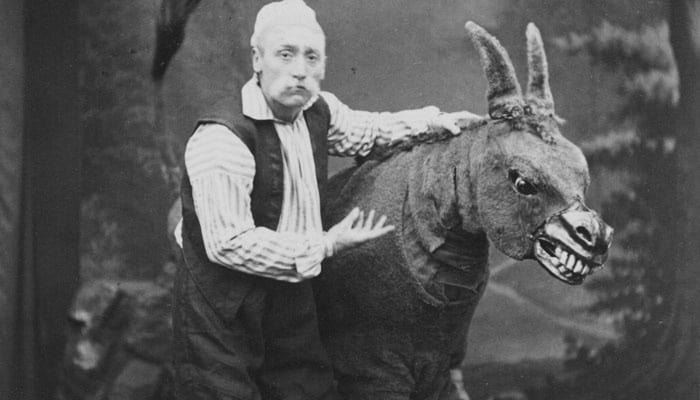
No Christmas would be complete without a visit to the pantomime. Now almost as big a tradition as eating turkey on Christmas Day, this humorous take on classic children's stories is always a big hit with families, but how long has the pantomime been entertaining audiences in Britain, and where did the pantomime horse come from?

© Public Domain / Wikipedia
History of the pantomime
Pantomime might seem like a great British institution, but it actually stems from Italy, where in the 16th century, street theatre performances, known as a harlequinade, would take place. Stock characters were used, taken from a masked slapstick type of comedy called Commedia dell'arte. Often, companies putting on these shows would go on tour, telling stories to audiences involving acrobatics, chases and magic.
The word pantomime itself means 'all kinds' of 'mime', and it's interesting to note that these early versions of the pantomime were unspoken, reflecting the 'mime' part of the word.
It was around the late 1600s that these travelling stories came to England, when comic plays would be performed. An acrobatic Harlequin character was a dominant feature, who had a slapstick role that often involved hitting things.
As the Victorian era dawned, pantomime started to become a Christmas staple. Plays would focus on fairytales or Robinson Crusoe, and it was at this time that the main male character would be played by a female.
Today, it's still very much tradition for the lead characters to be played by the opposite sex, especially the dame and principal boy. Slapstick comedy is integral, and audience participation is encouraged, especially with shouting 'he's behind you' when the baddie pops up on stage. Another great tradition of the pantomime is, of course, the pantomime horse.
Origins of the pantomime horse
The pantomime horse was a feature of the early commedia dell'arte pantomime shows, although it's thought that the ancient Greeks and Romans also used costumes to create a centaur and an ass.
It wasn’t until the late 19th century that two people were used to form the pantomime horse, which is what we still see in theatres today. In particular, in 1885, a pantomime horse featuring two acrobatic brothers, Fred and Joe Griffiths, was shown at the Royal Holborn theatre, called the Blondin Donkey. Many people regard this as the grandfather of the modern pantomime horse.
In more recent times, a pantomime horse named Pogo the Performing Horse featured at the London Coliseum in 1923, with a father and son playing the horse.
Pantomime horses today
As time has evolved, so too have the pantomime horses you'll see on stage, although they principally remain the same in that they consist of two actors. The first person plays the front part of the horse, including the head and front legs. They stand almost upright and can see through holes in the horse's head. The second person plays the rear end of the horse, including the back legs and torso. The actor bends his body horizontally and places his arms around the waist of the front person. Holes are often placed below the horse's torso, so the actor at the back can see where he's going.
It takes a lot of skill and effort for both actors to coordinate, especially if there is rapid movement involved in scenes, or even dancing!
While some horse costumes can be fairly basic, consisting of a sheet draped over the two actors, more elaborate examples will come with padded frames and a closed body to look more realistic. Often, these costumes may actually be two separate parts, rather than one single one. More complex suits may even contain moving parts that are operated from wires.
Although the horse is a common feature of the Christmas pantomime, you can also find similar versions used for zebras, cows or camels.
The pantomime horse certainly adds to the comedy of the show, but when it comes to kitting out your own horses, it's good to know that there's nothing slapstick about the high-quality equestrian products available from Griggs Equestrian.





